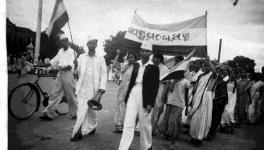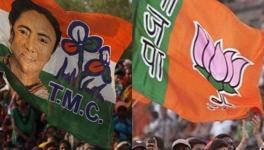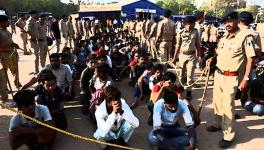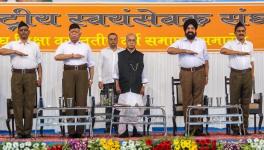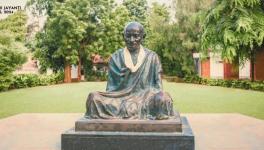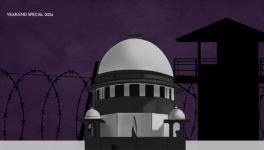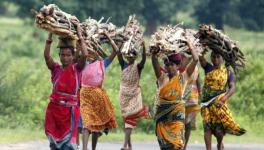Curse of Caste: Lessons from Ambedkar in Times of Corona
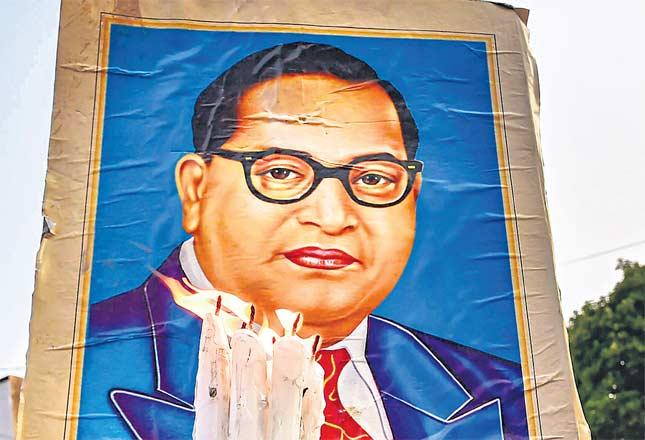
Image for representational use only.
Supermarkets in the more wealthy neighbourhoods of Delhi have done brisk business during the Covid-19 lockdown. Having marked themselves as serving essentials, they remained open through the lockdown. Their customers, who never were short of money, are ready to buy anything on their shelves, fearing shortages. Months of unsold inventories have been cleared without any discounts. While the rich and the comfortable line up in queues maintaining social distance at these supermarkets, behind them lives another world.
A five-year-old boy rummages through trash behind a row of such supermarkets in south-west Delhi. He is looking for eatables, and has collected a few half-rotten vegetables and fruits: a couple of mangoes, a bottle gourd, some potatoes and onions. He notices a plastic drum taller than himself and jumps to catch its edge so that he can topple it over. The drum is heavy; barely turns as the boy clutches its edge. The child, however, does not give up. After one high jump he manages to overturn it. Half-rotten vegetables in a gooey liquid pour out around him. He jumps back instinctively to avoid being submerged. There are enough eatables for him to collect in this pile. Among the crores of jobless working people facing deprivation in India these days, this boy may just have saved his family for a day.
Among all humans, children draw the maximum empathy from other humans. The state of the children of India’s working poor these days is only the tip of the iceberg of distress that all Indian working people are going through during the Covid-19 lockdown. Their distress migration has been reported on for 50 days and counting. Their deaths in road accidents and on railway tracks are making news headlines. For anyone with a heart, there is enough misery and anxiety all around.
Yet the elected government of the day appears confident in its heartlessness. It is more interested in using the Covid-19 pandemic as an opportunity to roll back laws meant to protect labour and push forward its long-term project of privatisation and FDI than in giving immediate financial aid to the jobless. While the dominant neo-liberal ideology does fortify the arrogant indifference towards working people, which is being displayed by all branches of the Indian state, there is more to it. After all even the USA—the bastion of neo-liberalism and “self-help” capitalism—has given direct financial aid to working families and extended payroll protection to employees of essential services in the private sector.
The behaviour of Prime Minister Narendra Modi’s government (in comparison with the Donald Trump administration in the United States) also cannot be blamed on the proverbial poor-vs-rich binary. India’s much-poorer eastern neighbour has disbursed direct financial aid to poverty-stricken households, which, at Tk2,500, is 50% more than the Indian government is promising to disburse to poor women in their Jan Dhan accounts. The Bangladesh government has also ensured through tripartite negotiations that garment-sector workers get an Eid bonus, and it has subsidised workers’ salaries for the duration of the Covid-19 lockdown.
In his thesis on famines and democracy, economist Amartya Sen famously argues that the necessity of facing regular elections and the relatively free flow of objective information in democracies builds public pressure on governments to act fast to prevent mass starvation. There is no reason to believe the same would not hold true for the current regime in India. If, on the other hand, all institutions of the Indian state—the Modi-led government, the judiciary and the bureaucracy—appear to be sitting pretty while crores of working people face the crisis of survival, it could only be that, to their common sense, the plight of working Indians does not count. Further that the people in power implicitly know that there are enough Indians who share their indifference.
Society as a myth:
One of the gravest missed opportunities of modern India is the way the first law minister Bhimrao Ambedkar has been reduced to an advocate of only the Scheduled Castes, and how little attention has been paid to his acute observations regarding Indian Hindu society. His most well-known essay, Annihilation of Caste, was not addressed to his fellow outcastes but to caste Hindus. Building upon his earlier thesis of caste as a segregated hierarchy, he asks the question: what type of society has caste created? Mistreatment of outcastes by caste Hindus is one obvious aspect of this society. His focus in this essay is on the nature of society as a whole. What kind of social relations does caste engender, not only between caste Hindus and outcastes but also among caste Hindus? His claim is that caste society is not a society in the normal sense of the word. He emphasises the segregation aspect of his thesis: “A caste has no feeling that it is affiliated to other castes except when there is a Hindu-Muslim riot. On all other occasions each caste endeavours to segregate itself and to distinguish itself from others.”
This means that there is “an utter lack among Hindus of what sociologists call ‘consciousness of kind’. There is no Hindu consciousness of kind.” The ‘consciousness of kind’, to Ambedkar, refers to how members of a society relate to one another. Do they see, even if only partially, a reflection of themselves in others? Its closest political concept is the fraternity of the French revolutionary slogan, which he much admired. A society with a deeper and wider consciousness of kind encourages its members, including the privileged, to notice the conditions of existence of others. This occurs as a matter of course, as a normal everyday social intercourse. Caste segregation is antithesis of fraternity.
Yet caste was not the only reality of India in Ambedkar’s time; it is even much less so now. It has always interacted with other components of the social dynamic. A unique feature of caste is its flexibility. As the public hold of religion has declined, caste has become secularised. It has adapted well to capitalism and liberal mode of governance. In Ambedkar’s time the factory floors of the textile mills in Bombay (now Mumbai) were segregated by caste, with the outcastes employed only in so-called menial jobs.
But since caste remains the first spontaneously-allotted community for most Indians, it is still a key determinant in the electoral calculus. In the era of reservations for oppressed castes, savarna castes now frame their self-consciousness in the idiom of “merit” rather than ritual purity. Caste has pushed many strands of even the anti-caste Dalit movement to become caste-centric. The point is, unless caste as a principle of social life is confronted in all aspects of Indians’ social life, it will continue to reproduce itself and prevent them from even becoming aware of the virtues of fraternity.
None of the dominant political and ideological discourses in modern India have tried the annihilation of caste that Ambedkar would have liked. The social basis of the nationalism of the freedom movement were mainly savarna Hindus who, due to their cultural and economic capital, were able to access modern systems of governance, education, employment and media. Broadly liberal in outlook, their nationalism imagined a national community extending back into millennia rather than emerging from a radical break from what existed.
Internal religious reform and opposition to hideous religious practices of the Hindus such as untouchability was fine, even desirable, but there was no need to churn what Ambedkar, while presenting the draft Constitution to the Constituent Assembly, called “an Indian soil which is essentially undemocratic”. In fact the era of Congress domination in Indian politics was a golden era for savarna Hindus. Radical land reform and universal and equal education for every Indian child—the two measures which would have seriously eroded their hold on society—were never tried. Expanding capitalism, bureaucracy and the higher education sector provided enough opportunities for their own economic and social mobility. The alternate Hindutva nationalism of the RSS remained marginal for them, even though it claimed to have deeper roots in Hindu traditions.
Twenty-first century India presents a very different scenario. The neo-liberal turn during the last three decades has created an appropriate politico-economic framework for capital to exert control over society. It has enhanced the social prestige of private property over state and communal resources. In the personal moral sphere it has strengthened demands for maximisation of personal interest and weakened the power and attraction of social ethics.
Yet, a liberal Manmohan Singh could never meet the political, cultural and social requirements of so-called aspirational India. In fact, Modi is the quintessential symbol of this new India. This India is oozing with an explosion of private and public religiosity and non-rational belief systems. Its aggressive Hindutva sees no need for internal religious reform. It actually finds solace in the existing Hindu religious world. Hence it is not just indifferent but actively hostile to Ambedkar’s question about the nature of Hindu society.
Taking away the weapons of the weak:
For the oppressed and the exploited of India, Ambedkar’s claim that there is ‘no consciousness of kind’ in Hindu society is more relevant than ever. Liberal statecraft, jurisprudence and ideology are built upon the assumption of a separation of the private and the public. These further assume that all members of a community have equal access to its public sphere and equal interests in strengthening it. The reality is far from this. In fact under capitalism and liberal governance the oppressed and exploited have opposite expectations from the public sphere than oppressors and exploiters.
Like an abusive husband who prefers his beatings to remain a private affair, capitalists too want workers’ wages and working conditions to remain a private arrangement. But the oppressed and the exploited know that their interests lie in making their oppression and exploitation public and fighting for public regulation of the conditions of their life. However, the support they can receive from the public sphere of the society depends crucially on whether the society has a weaker or a stronger ‘consciousness of kind’.
A society with no fraternity forces its members to suffer individually and silently. We see it happening most acutely with migrant workers. First the cities and regions where they work do not give them any space which they can call their own. So when a crisis strikes they hope to receive succour only back home, which could be hundreds if not a thousand or more kilometres away. And then, when they are forced out, they find it hard to organise, collectively protest and force authorities to take corrective steps. They leave, march, starve and silently die. The rest of society does not even care to mourn their death. The smugness of Indian rulers in the face of widespread distress of working poor is not hubris. They have a good sense of what kind of society India is. A society against which Ambedkar had warned long ago.
The author teaches physics at St Stephen’s College, Delhi. The views are personal.
Get the latest reports & analysis with people's perspective on Protests, movements & deep analytical videos, discussions of the current affairs in your Telegram app. Subscribe to NewsClick's Telegram channel & get Real-Time updates on stories, as they get published on our website.










